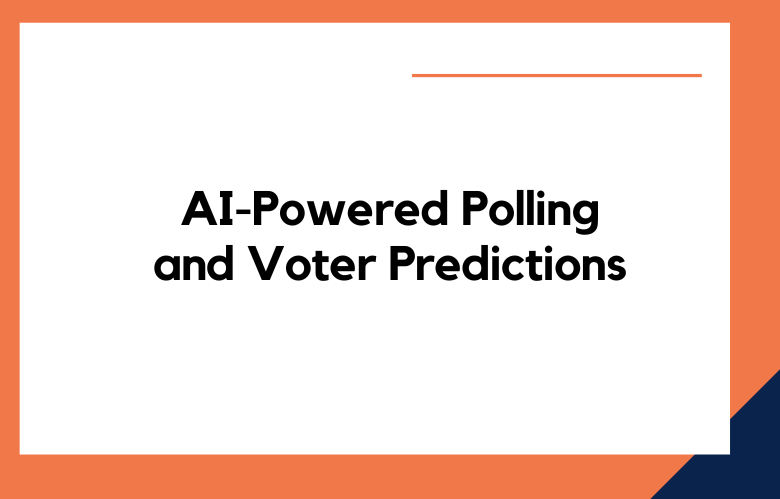Elections are the lifeblood of a democratic society, providing citizens with a say in the governance of their country. In recent years, however, election polling has come under intense scrutiny due to its accuracy and effectiveness. With unpredictable factors such as social media, disinformation campaigns, and shifting political landscapes, it has become increasingly more difficult to gauge the people’s will through traditional polling methods. This has led to the rise of AI-powered polling and voter predictions, which have the potential to revolutionize the way we approach the electoral process itself.
Understanding AI-Powered Polling
Traditionally, polling involves gathering data from a large and diverse sample of voters through in-person or phone surveys, which are then processed and analyzed to predict election outcomes. However, the rise of AI-powered polling has revolutionized this process.
AI-powered polling utilizes machine learning algorithms to gather and analyze vast amounts of data from multiple sources, including social media, news articles, and online forums. This provides a more in-depth and accurate picture of public sentiment than traditional polling methods.
Predicting Voter Behavior
In addition to providing more accurate predictions of election outcomes, AI-powered polling can also be used to predict and analyze voter behavior. AI algorithms can analyze social media posts and other online activity to identify patterns and trends in voter behavior that traditional polling methods may miss. This can be especially useful in identifying potential swing voters and predicting voter turnout on election day.
Fighting Disinformation
One of the most significant challenges of modern elections is the proliferation of disinformation campaigns designed to sway public opinion. AI-powered polling can help combat this by providing real-time analysis of social media and other online channels to identify and track fake news and propaganda. This can help political campaigns and election officials respond quickly and effectively to disinformation campaigns and take steps to protect the integrity of the electoral process.
Challenges and Controversies
As with any significant shift in the electoral process, AI-powered polling and voter predictions come with challenges and controversies. Critics argue that AI algorithms are inherently biased and may perpetuate inequalities and injustices in the electoral process.
Privacy concerns are also significant, as AI-powered polling relies heavily on data gathered from social media and other online sources. There is also a risk that AI-powered polling may manipulate or influence the vote rather than simply collect and analyze data.
The Future of Electoral Technology
Despite these challenges, the potential benefits of AI-powered polling and voter predictions are too great to ignore. As technology evolves, AI-powered polling will likely become an increasingly important part of the electoral process.
While there will always be challenges and controversies surrounding the use of technology in elections, the benefits of more accurate predictions, better voter analysis, and improved response to disinformation are too significant to ignore.
Forecasting the Future: AI-Powered Polling for Voter Predictions
As we approach election season, there is no doubt that polls will once again become an integral part of the political discourse. However, traditional polls often need to catch up in accurately predicting the outcome of elections. With the advent of artificial intelligence (AI), a promising solution is on the horizon.
AI-powered polling is a cutting-edge technology that utilizes machine learning algorithms to analyze and interpret voter sentiment. This technology can potentially revolutionize how we approach predicting election results. AI-powered polling can provide more accurate and nuanced insights into voter behavior by processing vast amounts of data from various sources, such as social media, news articles, and online forums.
The Rise of Smart Polling: AI Predictions for Election Outcomes
Artificial Intelligence (AI) in polling has taken a significant step forward in predicting election outcomes. Traditional polling methods, such as phone and mail surveys, must be updated and made more reliable due to changes in communication habits and the complexity of political landscapes. Smart Polling, on the other hand, combines multiple data sources with advanced machine learning algorithms to generate more accurate predictions with unprecedented speed and efficiency.
The rise of Smart Polling is attributed to its ability to tap into multiple data sources to generate more accurate predictions. In addition to traditional surveys, Smart Polling can use data from social media platforms, voter registration databases, demographic surveys, and even web browsing history.
The AI algorithms identify patterns in the data that are not immediately apparent to human pollsters, allowing for a more nuanced and detailed analysis of voter behavior.
The Accuracy Revolution: Leveraging AI for Voter Forecasting and Polling
The Accuracy Revolution, which involves using Artificial Intelligence (AI) for voter forecasting and polling, marks a significant milestone in election tracking and forecasting techniques. With the help of AI, experts can predict and analyze political trends with greater accuracy and efficiency than ever before.
One critical advantage of leveraging AI in voter forecasting and polling is its ability to process vast amounts of data in real-time. AI can provide insights that traditional polling methods cannot by analyzing multiple data points, such as demographics, voter sentiment, and political affiliations.
Furthermore, AI-powered forecasting models can continually adapt to new information, making them far more reliable than manual analysis methods. These models can accurately predict voter behavior and offer valuable insights to political parties, campaign strategists, and pollsters who can use this information to craft targeted political campaigns and messaging.
Polling Reinvented: How AI is Revolutionizing Voter Predictions
The traditional polling method has relied on random phone call surveys and in-person interviews, which can be time-consuming, expensive, and often need higher response rates. However, with the advent of AI, polling is being revolutionized by using cutting-edge technologies such as natural language processing, machine learning, and advanced algorithms.
One of the key benefits of using AI in polling is the ability to analyze millions of data points in real time, providing researchers with much more accurate and up-to-date insights into voter behavior and preferences. This helps increase the accuracy of predictions and enables pollsters to identify trends and patterns that might have gone unnoticed.
Beyond Polls: AI’s Role in Unveiling Voter Preferences
As technology advances, we see a growing trend in using artificial intelligence (AI) in various industries, including politics. In particular, AI has the potential to unveil voter preferences beyond traditional polling methods.
Traditional polling methods involve randomly sampling a population to gather information on their opinions or preferences. However, this method can often be biased or unreliable due to factors such as response bias or the influence of social desirability. Polls may not capture a population’s full range of opinions or attitudes.
On the other hand, AI can analyze large amounts of data and identify patterns or correlations that may not be immediately noticeable to humans. For example, AI can analyze social media data to determine what issues are most important to voters and what messages they respond positively or negatively to.
Unlocking Data Insights: AI-Driven Voter Predictions and Polling
Unlocking Data Insights through AI-driven voter predictions and polling has become an increasingly popular method of understanding voter behavior. With the introduction of machine learning algorithms, pollsters can now get an accurate understanding of the sentiments and opinions of voters. These analytics-driven predictions significantly shift from traditional polling methods, which could only give a rough estimate of voter behavior.
The use of AI in voter predictions and polling has enabled data scientists to employ advanced statistical methods to predict outcomes with unprecedented accuracy. These predictions are made by analyzing data from social media platforms, databases, and other sources. This data is then used to create predictive models that automatically detect patterns and trends in voting behavior. These predictions can be used to make informed decisions about political campaigns, messaging, and fundraising.
Conclusion:
AI-powered polling and voter predictions can revolutionize the electoral process, providing more accurate forecasts of election outcomes, better voter analysis, and improved response to disinformation campaigns. While challenges and controversies are indeed associated with using AI in elections, the benefits are too great to ignore.
As technology continues to evolve, it will be essential that we find ways to harness the power of AI while protecting the integrity of the electoral process and ensuring that everyone has a fair and equal voice in our democracy.
Call: +91 9848321284
Email: [email protected]











